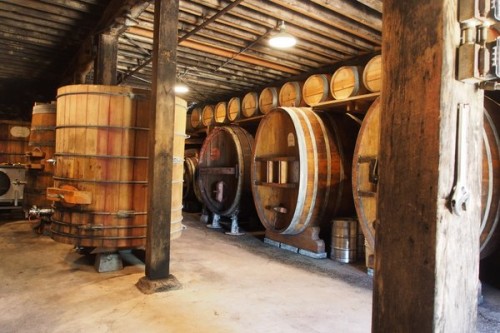
It’s very easy to lose perspective. In wine as in life. And none of us are totally immune to fashions, to trends, and the latest movements. And if we get swept up by these trends, we can drift easily into dogma. It’s something that’s best avoided. [The problem is, if we realized our loss of perspective, then we’d probably take steps to correct it. Usually, we don’t.]
Let’s give some examples from the world of wine. Acidification is one. Now I don’t like acidification, and it’s something that I would try to avoid if I were making wine. But in some places, in some vintages, even skillful viticulture can’t obviate the need for a little tartaric acid correction in the winery. [One example would be in Central Otago, where it’s very hard to avoid acidification because of an unexplained dropping out of acid during fermentation.] New oak is another: generally, I think new, small oak is used far too often in premium wines. The taste of oak in a wine could be considered to be a flaw. But some great wines are made in 100% new oak. And all wineries will presumably need to buy the odd new barrel, if they are using barrels (unless of course they buy-in used barrels). I refuse to be dogmatic about new oak and acidification.
This doesn’t mean I don’t have a view. For example, I have strong views on picking times. I reckon that picking too late is one of the besetting sins of the modern wine industry. The concept of picking by flavour/seed colour/physiological (psychological?) ripeness is one of the collective delusions of today’s winemaking scene. By the time grapes taste ripe, they are over-ripe. There are so many wines that could be improved by picking the grapes two weeks earlier: it would result in more interesting, detailed, fresh and ageworthy wines. Just like they used to be made. Right bank Bordeaux is particularly bonkers in this regard. So I have a view. And it’s good to see this concept of ripeness beginning to change. If things carry on this way, it may well become quite fashionable to pick earlier. This is where we run into a problem. I have a strong opinion on ripeness, but I could become dogmatic about this and lose sight of perspective. The fashion for early picking could lead winegrowers to listen less carefully to their sites. Some terroirs simply don’t allow for 12% alcohol wines; others do. And to be able to pick earlier, winegrowers have to do a lot of good work in their vineyards to make sure there is homogeneous ripeness that allows for such an early harvest. Unripeness is a real thing: it exists. Please save us from a situation where we reward a wine for what it is not (too ripe), rather than for positive virtues of its own.
Part of the problem with fashion and dogma is the way we are educated in western societies. We tend to think dualistically. Right or wrong. True or false. We are not good at holding in tension several statements that appear to contradict each other. We don’t like a synthesis of ideas, approaching an issue from several directions and drawing on several disciplines. Our education system, for example, sends us in one of two directions at an early stage: arts or science. And we over-value science and under-value the arts as ways of understanding and explaining the world.
As a wine writer, I’d probably find it easier if I took a position and ran with it. If I hammed it up a bit and made controversial statements, I might get more attention. For example: natural wine. I’m very interested in this topic, but I refuse to take the caricature of a position (natural wines versus chemical industrial wines) that has served some other writers very well. I’m striving for balance and fairness in my writing. I don’t always get there, of course.
A word of caution is needed here. The ‘truth’ (whatever that is) is sometimes found at the extremes. Being a thoughtful observer, with a balanced viewpoint, doesn’t always lead you to the middle ground between two opposing ‘truths’. The correct (as in intellectually most defensible) position can be at the margins. Not often, but sometimes.
In short, we just need to think a bit more intelligently. And be aware of our own tendency to lose perspective.
2 Comments on On bias, dogma and fashion in the wine world


Yes, living as we do in these times, in the midst of a wave of free-market capitalism, it’s hardly surprising that many wineries are focused on profit-chasing as opposed to trying to make beautiful terroir-expressing wines. But all things come to an end. I reckon that free-market capitalism has a long time to go, but on a smaller scale of things, I also believe that the taste or ‘fashion’ for international, Parkerized, hi-alcohol, loadsa fruit and oak type wines, is starting to wane at last, after decades of hegemony. On the one hand I think its a terrible shame and tragedy that so many winemakers have gone over to the dark side in the name of profit-chasing and Parker Point chasing, and have stopped making their typical regional style of wines. But on the other hand, I like to think that with his dumbed down and stupid points system of rating wines, Parker has expanded the wine market and brought many new customers into the world of wine, who previously would not have bought or drank wine, because they were intimidated or embarassed or whatever. Hopefully these newbies will branch out and discover that there are many many styles of wine in the world, not just the one that Mr Parker enjoys. But we are surrounded by dogmatic people all blasting away on their own trumpets. Sometimes I feel that we lose sight of the fact that wine is meant to be enjoyed, and so for me that means that it has to smell and taste good; and it also helps if I know that it was produced in a respectful sustainable and non-poluting manner; and if it’s produced in a typical regional style, that’s interesting and cultural and adds to the pleasure too.
If you are not living on the edge you are taking up too much room.